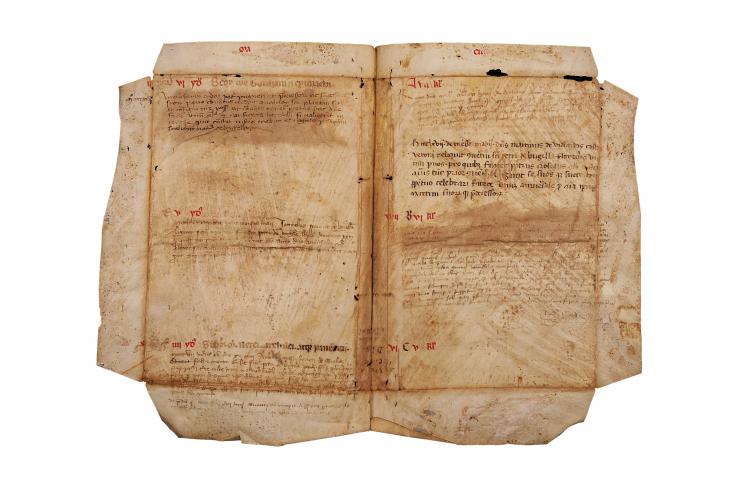Dal sec. XIV al sec. XVI - Coperte pergamenacee, 355x250 e 380x280 mm - Biblioteca diocesana Agnesiana, Vercelli (Fondo Sant’Andrea)
- Le due coperte pergamenacee del fondo Sant’Andrea della Biblioteca diocesana Agnesiana riportano necrologi del convento di San Pietro di Biella, riferibili dal XIV al XVI secolo.
In particolare su una di queste si legge: “Sol in geminis […]”, in queste poche righe ci si riferisce al codice De proprietatibus rerum.
I necrologi attestano l’appartenenza ai frati Eremitani di Sant’Agostino di Biella.
La stessa Biblioteca diocesana Agnesiana possiede un’edizione incunabola di De proprietatibus rerum, stampata da Pietro Ungaro, il 21 novembre 1482 a Lione. Le note manoscritte riconducono ai Francescani vercellesi, chiaramente la nota di possesso.
L’opera era molto in voga, la prima edizione incunabola conosciuta risale al 1470 circa, Basilea, e si contano più di quattordici edizioni prima del 1500.
A Vercelli erano presenti almeno due esemplari dell’opera di Batholomew de Glanville, il manoscritto presso i domenicani di San Paolo e l’incunabolo in uso ai Francescani.
- The two parchment covers of the fund of St.Andrew in the Biblioteca Diocesana Agnesiana display obituaries from the convent of St. Peter in Biella referring to the period between the XIV and the XVI centuries.
Specifically in one of these it is possible to read : " Sol in geminis [....]", in these few lines there is a reference to the code De Proprietatibus Rerum.
The obituaries confirm the fact of it belonging to the Hermit Friars of St. Augustine of Biella.
The same Biblioteca Diocesana Agnesiana possesses an incunable edition of De Proprietatibus Rerum, printed by Peter Ungaro on the 21st November 1482 in Lyons. The handwritten notes lead back to the Franciscans of Vercelli clearly showing their possession.
The opera was very fashionable; the first known incunable edition dates back to 1470 circa in Basel. There were more than fourteen editions before 1500.
In Vercelli, there were at least two specimens of the work by Bartholomew de Glanville : the manuscript at the Dominican convent of St. Paul and the incunable edition used by the Franciscan Friars.
- Les deux couvertures en parchemin du fond Saint-André de la Biblioteca Diocesana Agnesiana rapportent des nécrologes du couvent de Saint Pierre de Biella, du XIV au XVI siècle.
En particulier on lit sur une d’elles : “Sol in geminis […]”, dans ces quelques lignes on fait référence au code De proprietatibus rerum
Les nécrologes prouvent l’appartenance aux frères Ermites de Saint Augustin de Biella.
La Biblioteca diocesana Agnesiana possède une édition incunable de De proprietatibus rerum, imprimée par Pierre Ungaro, le 21 novembre 1482 à Lyon. Les notes manuscrites renvoient aux Franciscains de Vercelli, clairement un signe de propriété.
L’œuvre était très en vogue, la première édition incunable connue date de 1472 environ, Bâle, et on compte plus de quatorze éditions avant 1500,
A Vercelli au moins deux exemplaires de l’œuvre de Bartholomew de Glanville étaient présents le manuscrit chez les dominicains de Saint Paul et l’édition incunable utilisée par les Franciscains.
